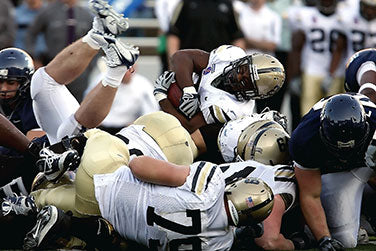Have you ever wondered why it seems like some college athletes look way older than you remember 18 to 22 year olds looking like when you were “college age”?
While there are a lot of environmental factors and other generational changes that affect how kids are developing and acting these days, college sports also have eligibility requirements that can allow older people to participate in college sports.
College sports is just as competitive, and sometimes more so, than professional sports, which leads to many schools seeking out the best of the best when it comes to sports. This means that the athletes you see on the fields, or the courts were mainly hand selected by a group of scouts or recruiters to help build the best team they can for their school. And because of this you’re going to get students that are the biggest snd strongest competitors all in one place.
This also means that as long as players meet those eligibility requirements set forth by the NCAA, they may not fall into the age group that we would perceive as “typical college age”.
So how do the eligibility requirements work for college sports?
College Sports Years of Eligibility
Because of the COVID pandemic in 2020, and the resulting cancelation of a lot of college sports programs, there have been some extensions to the eligibility of those athletes that were affected. Since that was an unforeseen issue, and not typically considered when discussing NCAA sports eligibility policy, we will be focusing just on the traditional rules regarding NCAA sports eligibility in normal years.
In regards to your
eligibility timeline, athletes playing in a division 1 program have 5 calendar years to play 4 seasons of sports starting from the time they enroll as a full-time student.
This means that regardless of when you finished high school, as long as you have not enrolled into a college full-time, your eligibility remains at 5 years. This means that even if you were 30 years old and were beating out 20-year-olds at their positions, you could technically play college sports for the next 5 years.
Although you would still be eligible to play, regardless of your age, collegiate sports are extremely competitive and the talent of some of these younger kids is incredible. As you get older it’s harder to keep up with them, but if you’re blessed enough to be able to do so, that college eligibility may still be open to you.
When it comes to Division 2 schools the eligibility requirements are a little different. Instead of having 5 years to complete your four seasons of a sport you have the first 10 semesters of 15 quarters starting from when you first enrolled as a full-time student.
Division 2 schools also stop their clocks if you only attend part time for a semester/quarter or you are not enrolled at all for a term. This differs from division 1 schools as your clock continues to run with no breaks regardless of whether you are still enrolled. As soon as you enroll full-time that first year the clock starts and continuously runs.
Full-time student means that you are registered for at least 12 credit hours at your school. Some colleges consider less than 12 credit hours as being full-time, but NCAA sports require athletes to be enrolled in at least 12 hours regardless.
Academic Eligibility Requirements
In addition to the years of eligibility requirements in NCAA sports, the NCAA also requires certain academic standards to be met in order to participate.
These requirements are based off of core course requirements taken in high school as well as the GPA sustained throughout those core courses. The NCAA also takes into account SAT and ACT scores, in combination with your GPA, to determine eligibility.
Division 1 and division 2 schools have their own set of eligibility requirements which you can find
here. At the center of the requirements is that you must have graduated high school and completed the 16 core courses required. You may also be required to have received a 2.3 GPA or higher in those core courses in order to qualify.
For a full list of course eligibility requirements click here.
College Sports Eligibility
The good news, when it comes to college sports, is that as long as you have never enrolled in college full-time, you have 5 years of eligibility starting from the first time you do enroll full-time. This means that even if you did not go to college right out of high school, you’ll still maintain all 5 years (4 seasons) of eligibility when you do enroll.
So as long as you meet all of the other requirements, and you can still hang with the younger kids, there’s no reason you shouldn’t go out and try for a walk-on spot on a team.









